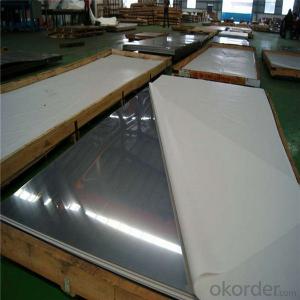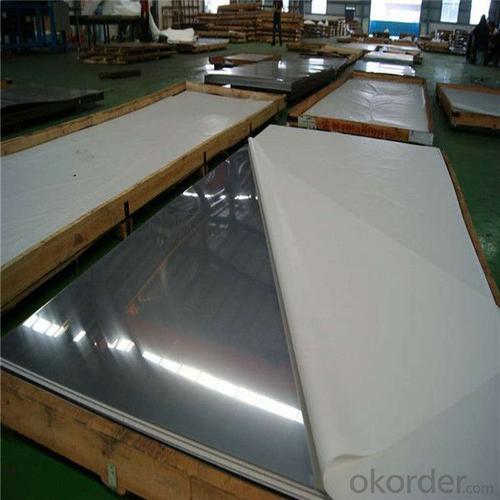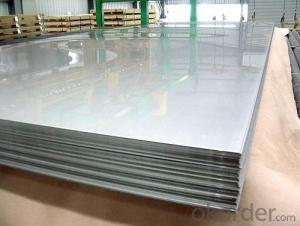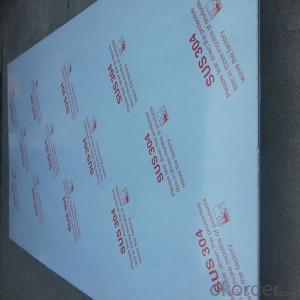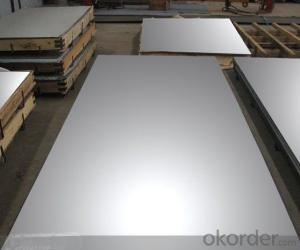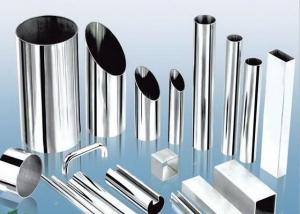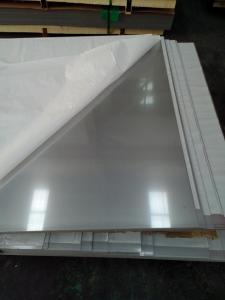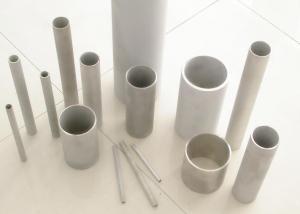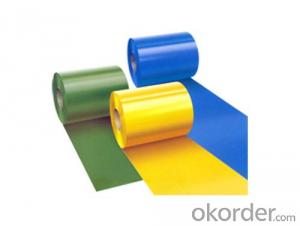310S Stainless Steel Sheet / S S sheet 310s
- Loading Port:
- Shanghai
- Payment Terms:
- TT OR LC
- Min Order Qty:
- 3 m.t.
- Supply Capability:
- 2000 m.t./month
OKorder Service Pledge
OKorder Financial Service
You Might Also Like
Specification
310S Stainless Steel Sheet / S S sheet 310s
We can produce un-standard size stainless steel sheet as customer required.
Material Feather
310 s stainless steel plate is 25 cr - ni is 20 high alloy stainless steel, high temperature oxidation resistance, suitable for making various furnace with a component, the highest temperature 1200 ℃, continuous working temperature 1150 ℃. Purpose: furnace materials, purification devices of automobiles.
Chemical composition
C :≤0.08, Si :≤1.00, Mn :≤2.00, P :≤0.035, S :≤0.030, Ni :≤19.00-22.00, Cr :≤24.00-26.00
Detail information:
1. Steel grade: 310S
2. Surface: 2B, BA, No. 4, 8K(mirror), HL, embossing, etching. And more than 100 different patterns for your choice.
3. Colors: Golden, rose golden, titanium golden coating, champagne golden, brown, bronze, titanium black, sapphire blue, purple, gray, silver, coffee champagne, jade-green, etc.
4. Thickness: 0.3-120mm
5. Width: 500mm, 1000mm, 1219mm, 1500mm, 1800. And length: Could be cut into any size as per customer's request. Usually our common sizes: 1219mm*2438mm (4*8ft), 1219mm*3048mm (4*10ft) and 1000mm*2000mm.
6. Standard: AISI, SUS, etc.
7. Packing: Standard sea-worthy packing, cover with PVC, and wooden case, or customize package.
8. Application:
Architectural decoration, luxury doors, wall decoration plate, elevators decorating, KTV indoor decoration, metal tank shell, ship building, decoration inside the train, as well as outdoor works, advertising name plate, the ceiling and cabinets, aisle panels, screen, the tunnel project, hotels, guest houses, entertainment place, kitchen equipment, light industrial and others.
9. Advantage: Colorful, showing the splendor of your quality, wear-resistant as well, strong corrosion resistance, anti-rust property and decorative effect, durable and beautiful in good taste.
10. Supplier Product Code: SDJM
11. Competitive Advantages of the product
1) Stainless Steel Decorative Sheet
2) Customize pattern and color coating
3) Advantage: Various patterns, splendid decorative effect, fashionable design
4) Surface finish: Mirror, 2b, no.1, no.4, 6k, 8k, polished, etc
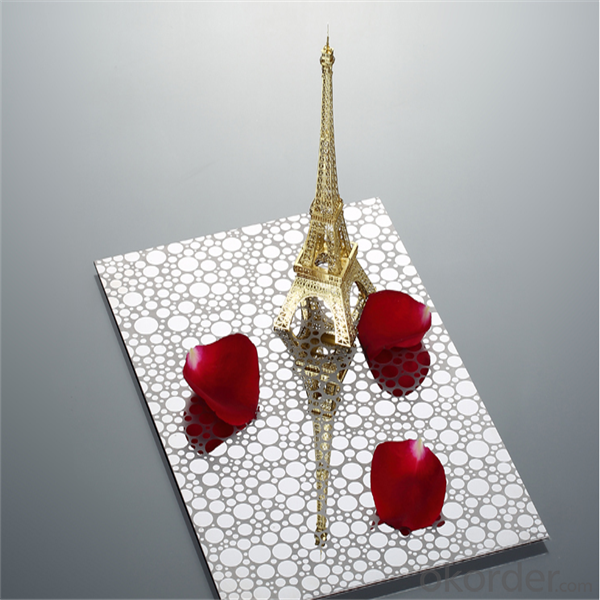

- Q: Are stainless steel sheets non-magnetic?
- No, stainless steel sheets are not inherently non-magnetic. While certain types of stainless steel can be non-magnetic, such as the austenitic variety (grades like 304 and 316), many other types of stainless steel can still exhibit magnetic properties. This is particularly true for ferritic and martensitic stainless steels. The magnetism in stainless steel is determined by its composition and crystal structure. So, if you are specifically looking for non-magnetic stainless steel sheets, you should opt for the austenitic grades.
- Q: How do I prevent intergranular corrosion on stainless steel sheets?
- To prevent intergranular corrosion on stainless steel sheets, there are several steps that can be taken: 1. Opt for the appropriate stainless steel grade: Choose stainless steel grades that are specifically designed to resist intergranular corrosion, such as 304L, 316L, or 321. These grades have a lower carbon content, which minimizes the formation of chromium carbides at grain boundaries. 2. Apply heat treatment: After fabrication or welding, subject the stainless steel sheets to a solution annealing or post-weld heat treatment process. This treatment eliminates any chromium carbides that may have formed during welding or high-temperature processing, effectively preventing intergranular corrosion. 3. Avoid high temperature exposure: It is crucial to avoid subjecting stainless steel sheets to temperatures between 450 to 850 degrees Celsius (842 to 1562 degrees Fahrenheit) for extended periods. Prolonged exposure to such temperatures can lead to the formation of chromium carbides at the grain boundaries, rendering the stainless steel susceptible to intergranular corrosion. 4. Utilize proper welding techniques: When welding stainless steel sheets, it is important to employ low heat input and minimize the duration of exposure to high temperatures. These measures help reduce the formation of chromium carbides and preserve the corrosion resistance of the stainless steel. 5. Employ pickling and passivation: After fabrication or welding, ensure that the stainless steel sheets undergo thorough pickling and passivation. Pickling removes any surface contaminants, while passivation forms a protective oxide layer that prevents intergranular corrosion. 6. Regularly maintain and clean: To prevent potential corrosion, it is essential to keep the stainless steel sheets clean and free from contaminants. Regularly clean the surfaces using mild detergents and avoid the use of harsh chemicals or abrasive materials that may damage the protective oxide layer. By following these preventative measures, the risk of intergranular corrosion on stainless steel sheets can be significantly reduced, allowing for the preservation of their corrosion resistance properties and an extended lifespan.
- Q: What are the different types of surface treatments for stainless steel sheets?
- There are several types of surface treatments for stainless steel sheets, including brushing, grinding, polishing, and coating. Brushing creates a textured finish, grinding removes imperfections, polishing enhances shine, and coating adds a layer of protection.
- Q: Can stainless steel sheets be used for medical sterilization equipment?
- Certainly, medical sterilization equipment can indeed utilize stainless steel sheets. Due to its exceptional resistance to corrosion, impressive heat resistance, and remarkable durability, stainless steel stands as a favored material choice within the medical industry. These remarkable attributes render stainless steel sheets perfectly suited for a wide array of medical applications, including the construction of sterilization equipment. With the ability to endure high temperatures and endure multiple sterilization cycles without warping or deteriorating, stainless steel sheets prove themselves suitable for autoclaves and other sterilization devices. Moreover, stainless steel's effortless cleaning and maintenance capabilities play a critical role in preventing the proliferation of bacteria and other harmful microorganisms. As a result, stainless steel sheets find widespread usage in medical settings where the presence of sterilization equipment is imperative.
- Q: Can stainless steel sheets be formed into different shapes?
- Stainless steel sheets possess the capability to assume diverse shapes. Such sheets are composed of a flexible material, which can be effortlessly altered using multiple techniques like bending, rolling, and stretching. Consequently, stainless steel sheets can be transformed into a wide array of configurations, encompassing curves, angles, cylinders, and intricate geometries. The pliability and ductility of these sheets render them exceptionally suitable for applications necessitating personalized shapes and designs. Moreover, owing to its resistance against corrosion and high temperatures, stainless steel is extensively utilized in shaping various forms within industries such as architecture, construction, automotive, and manufacturing.
- Q: How do you join stainless steel sheets together?
- Different methods can be employed to connect stainless steel sheets, depending on the desired outcome and specific application. Here, we present a few commonly used techniques: 1. Welding: Stainless steel sheets can be welded using various methods like TIG (Tungsten Inert Gas), MIG (Metal Inert Gas), or spot welding. Through welding, a strong and enduring bond is formed between the sheets, ensuring a secure connection. 2. Mechanical Fastening: By utilizing mechanical fasteners such as screws, bolts, or rivets, stainless steel sheets can be effectively joined. This approach is commonly employed when disassembly or reassembly is necessary, as it allows for easy removal and reinstallation. 3. Adhesive Bonding: Specialized adhesives specifically designed for stainless steel can be utilized to connect sheets together. These adhesives create a robust bond while preserving the aesthetics of the stainless steel surface. However, adhesive bonding may not be suitable for applications involving high stress or temperature. 4. Clinching: The clinching method involves applying a special tool to press the stainless steel sheets together, resulting in a mechanical interlock. This technique is frequently used for joining thin sheets and offers a cost-effective and expeditious solution. When selecting the most suitable method, it is crucial to consider the project's specific requirements, including load-bearing capacity, temperature, corrosion resistance, and aesthetics. Seeking guidance from a professional or conducting thorough research can assist in ensuring that the chosen joining technique is appropriate for the intended application.
- Q: Can stainless steel sheets be used for chemical mixing tanks?
- Indeed, chemical mixing tanks can utilize stainless steel sheets. Stainless steel proves to be a favored option for chemical mixing tanks because of its remarkable resistance to corrosion and its enduring nature. It can withstand a broad spectrum of chemicals and endure high temperatures, rendering it suitable for diverse chemical mixing purposes. Maintaining the purity of the blended chemicals is effortless with stainless steel sheets as they are easy to clean and upkeep. Furthermore, stainless steel exhibits non-reactivity, guaranteeing the preservation of the mixture's integrity by preventing any interaction between the metal and the chemicals being mixed. In summary, stainless steel sheets offer a dependable and effective material choice for chemical mixing tanks.
- Q: How do I bend or form stainless steel sheets?
- To achieve the bending or forming of stainless steel sheets, the following steps can be followed: 1. The first step is to select the appropriate stainless steel grade. Stainless steel is available in various grades, each with its own unique properties. It is important to choose the grade that best fits the requirements of your project, considering factors such as corrosion resistance, strength, and formability. 2. The next step involves using the correct tools. Specific tools like a hydraulic press brake or a metal bending machine are necessary for bending stainless steel sheets. These tools apply force evenly, ensuring precise and consistent bends. It is crucial to use tools that are designed for stainless steel in order to avoid damaging the material. 3. Before bending, it is essential to prepare the stainless steel sheet. This includes ensuring that the sheet is clean and free from any dirt or debris. Additionally, marking the desired bending lines on the sheet using a pencil or tape can serve as a guide throughout the process. 4. The bending angle and radius need to be determined based on the specific requirements of the project. This can be done by using a protractor or a template to accurately measure and mark the desired angles. 5. To prevent any movement or slipping during the bending process, it is important to securely clamp the stainless steel sheet to the bending tool or machine. This will ensure stability and accuracy throughout the bending process. 6. The next step involves applying pressure gradually. It is recommended to start the bending process slowly and gradually increase the pressure. This helps prevent the stainless steel sheet from cracking or warping. Close attention should be paid to the bending process to ensure that the desired shape is achieved without any defects or deformation. 7. If there is a need to create multiple bends or complex shapes, the process can be repeated as necessary. Each bend should be carefully measured and aligned with the previous bends to achieve a consistent and accurate result. 8. After bending the stainless steel sheet, any residual marks or burrs can be removed using a file or sandpaper. This will give the finished product a smooth and polished appearance. It is important to keep in mind that bending stainless steel sheets can be challenging, particularly for thicker gauges or harder grades. It is advisable to practice on scrap pieces or seek professional assistance if you are uncertain or lack experience in working with stainless steel.
- Q: What drill can drill stainless steel?
- Stainless steel is characterized by high toughness and easy sticking. Therefore, the drill hardness is required to be high, the surface finish is better, the drill bit angle is larger than the ordinary bit (130--135 degrees). Cool down at the same time. And the feed amount is greater than 0.15mm, so as not to cut the cold work hardening layer as much as possible. The cutting speed is as low as possible to reduce the cutting temperature. The cutting fluid is concentrated with emulsions. Commonly used processing stainless steel drill bit: high cobalt drill (M35 drill, M42 drill), in which the M42 bit is the best price performance. In addition, carbide drills can be used, but the price is higher.
- Q: What is the maximum thickness of stainless steel sheets for bending?
- The maximum thickness of stainless steel sheets for bending depends on several factors such as the type of stainless steel, the bending method used, and the equipment available. In general, stainless steel sheets up to 3/16 inch (4.76mm) thick can be readily bent using common bending techniques and equipment. However, thicker sheets may require specialized machinery or processes such as hydraulic or press braking to achieve the desired bend. It is important to consult with a metal fabrication expert or refer to specific bending guidelines provided by the stainless steel manufacturer to determine the maximum thickness that can be effectively bent for a particular application.
Send your message to us
310S Stainless Steel Sheet / S S sheet 310s
- Loading Port:
- Shanghai
- Payment Terms:
- TT OR LC
- Min Order Qty:
- 3 m.t.
- Supply Capability:
- 2000 m.t./month
OKorder Service Pledge
OKorder Financial Service
Similar products
Hot products
Hot Searches
Related keywords
